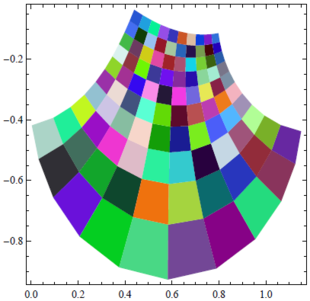14-240/Tutorial-October7: Difference between revisions
| (13 intermediate revisions by the same user not shown) | |||
| Line 9: | Line 9: | ||
=====Proof 1===== |
=====Proof 1===== |
||
Let <math>W_1</math>, <math>W_2</math> be subspaces of a vector space <math>V</math>. |
Let <math>W_1</math>, <math>W_2</math> be subspaces of a vector space <math>V</math>. |
||
<math>\implies W_1 \subset W_2 \or W_2 \subset W_1</math>. |
We show that <math>W_1 \cup W_2</math> is a subspace <math>\implies W_1 \subset W_2 \or W_2 \subset W_1</math>. |
||
:Assume that <math>W_1 \cup W_2</math> is a subspace. |
:Assume that <math>W_1 \cup W_2</math> is a subspace. |
||
| Line 25: | Line 25: | ||
:Case 1: <math>x + y \in W_1</math>: |
:Case 1: <math>x + y \in W_1</math>: |
||
::Since <math>x \in W_1 |
::Since <math>x \in W_1</math> and <math>W_1</math> has additive inverses, then <math>(-x) \in W_1</math>. |
||
::Then <math>(x+y)+(-x)=y \in W_1</math>. |
::Then <math>(x+y)+(-x)=y \in W_1</math>. |
||
| Line 31: | Line 31: | ||
:Case 2: <math>x + y \in W_2</math>: |
:Case 2: <math>x + y \in W_2</math>: |
||
::Since <math>y \in |
::Since <math>y \in W_2</math> and <math>W_2</math> has additive inverses, then <math>(-y) \in W_2</math>. |
||
::Then <math>(x+y)+(-y)=x \in W_2</math>. |
::Then <math>(x+y)+(-y)=x \in W_2</math>. |
||
| Line 43: | Line 43: | ||
Let <math>V=\{(a_1, a_2):a_1, a_2 \in R\}</math>. Then <math>\forall (a_1, a_2), (b_1, b_2) \in V, \forall c \in R</math>, define |
Let <math>V=\{(a_1, a_2):a_1, a_2 \in R\}</math>. Then <math>\forall (a_1, a_2), (b_1, b_2) \in V, \forall c \in R</math>, define |
||
<math>(a_1, a_2) + (b_1, b_2) = (a_1 + 2b_1, a_2 + 3b_2)</math> and <math>c(a_1, a_2)=(ca_1, ca_2)</math>. |
::<math>(a_1, a_2) + (b_1, b_2) = (a_1 + 2b_1, a_2 + 3b_2)</math> and <math>c(a_1, a_2)=(ca_1, ca_2)</math>. |
||
space over <math>R</math>. |
We show that <math>V</math> is not a vector space over <math>R</math>. |
||
:We show that <math>V</math> is not commutative. |
:We show that <math>V</math> is not commutative. |
||
| Line 51: | Line 51: | ||
::Let <math>(a_1, a_2) = (0, 0)</math>. |
::Let <math>(a_1, a_2) = (0, 0)</math>. |
||
::Then <math>(0, 0) + (b_1, b_2) = (2b_1, 3b_2) \neq (b_1, b_2 |
::Then <math>(0, 0) + (b_1, b_2) = (2b_1, 3b_2) \neq (b_1, b_2)</math>. |
||
::Then <math>V</math> is not commutative. |
::Then <math>V</math> is not commutative. |
||
:Then <math>V</math> is not a vector space. ''Q.E.D.'' |
:Then <math>V</math> is not a vector space. ''Q.E.D.'' |
||
| Line 62: | Line 61: | ||
In Proof 1, the equivalence of (2) the last line and (1) the "let" statement to the second last line is not obvious: |
|||
=====Error in Proof 1===== |
|||
| ⚫ | |||
The error in the proof is the logical equivalence of these two statements. |
|||
| ⚫ | |||
(2) Then <math>W_1 \subset W_2 \or W_2 \subset W_1</math>. |
(2) Then <math>W_1 \subset W_2 \or W_2 \subset W_1</math>. |
||
Rewrite sentences (1) and (2) into a form that is easier to compare: |
|||
=====Error in Proof 2===== |
|||
(1) <math>\forall x \in W_1, \forall y \in W_2, (x \in W_2 \or y \in W_1)</math>. |
|||
(2) <math>( \forall x \in W_1, x \in W_2) \or ( \forall y \in W_2, y \in W_1)</math>. |
|||
For Proof 1 to be correct, we must show that sentences (1) and (2) are equivalent. Alternatively, alter the structure of Proof 1 into a proof by contradiction. |
|||
In Proof 2, the only thing that is shown is that <math>(0, 0)</math> is not the additive identity. For Proof 2 to be correct, either plug in a vector that is not <math>(0, 0)</math> or show that <math>(0, 0)</math> is the additive identity by some other means, which introduces a contradiction. |
|||
==Nikita== |
==Nikita== |
||
Latest revision as of 20:31, 7 November 2014
| |||||||||||||||||||||||||||||||||||||||||||||||||||||||||
Boris
Subtle Errors in Proofs
Check out these proofs:
Proof 1
Let , be subspaces of a vector space .
We show that is a subspace .
- Assume that is a subspace.
- Let , .
- Then .
- Then .
- Then .
- Case 1: :
- Since and has additive inverses, then .
- Then .
- Case 2: :
- Since and has additive inverses, then .
- Then .
- Then .
- Then . Q.E.D.
Proof 2
Let . Then , define
- and .
We show that is not a vector space over .
- We show that is not commutative.
- Let .
- Then .
- Then is not commutative.
- Then is not a vector space. Q.E.D.
Can you spot the subtle error in each?
In Proof 1, the equivalence of (2) the last line and (1) the "let" statement to the second last line is not obvious:
(1) Let . [Many lines] Then .
(2) Then .
Rewrite sentences (1) and (2) into a form that is easier to compare:
(1) .
(2) .
For Proof 1 to be correct, we must show that sentences (1) and (2) are equivalent. Alternatively, alter the structure of Proof 1 into a proof by contradiction.
In Proof 2, the only thing that is shown is that is not the additive identity. For Proof 2 to be correct, either plug in a vector that is not or show that is the additive identity by some other means, which introduces a contradiction.






























